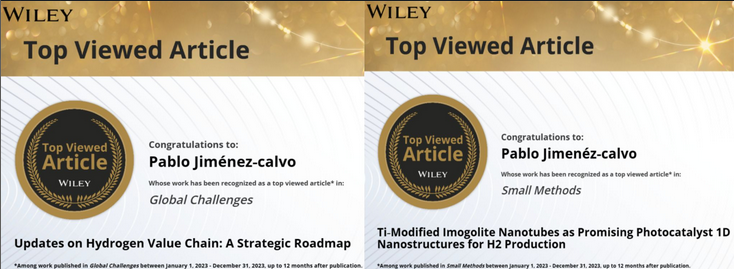We are pleased to share that Pablo Isaí Jiménez Calvo’s research continues to gain international recognition. For the third consecutive year, his work has been featured by Wiley, highlighting important contributions to future energy technologies.
This year, two complementary publications focus on hydrogen from different angles:
🔹 Hydrogen Value Chain
A comprehensive review addressing hydrogen production, transport, storage, and supply—covering the entire value chain for building a sustainable hydrogen economy.
📖 Read more here
🔹 Emerging Photoelectrocatalysts
A novel study introducing a doping strategy with imogolite nanotubes, creating a unique transversal band structure and enhancing photocatalytic hydrogen production—driven by solar energy.
📖 Read more here
Both works contribute to advancing sustainable solutions, from system-level infrastructure to materials-level innovation.
The research was carried out at the Max Planck Institute of Colloids and Interfaces and at Université Paris-Saclay (CNRS), with support from the Marie Skłodowska-Curie Actions, the European Research Executive Agency (REA), and the European Commission.
Special thanks go to all collaborators from Germany, France, the United Kingdom, Switzerland, Italy, Spain, the United States, and Malaysia.
Carbon-Inorganic Interface Materials for Sustainable Photoelectrocatalytic Solar Fuels and Rich ChemicalsBachmann Group
Department of Chemistry and Pharmacy

We are pleased to share that Pablo Isaí Jiménez Calvo’s research continues to gain international recognition. For the third consecutive year, his work has been featured by Wiley, highlighting important contributions to future energy technologies.
This year, two complementary publications focus on hydrogen from different angles:
🔹 Hydrogen Value Chain
A comprehensive review addressing hydrogen production, transport, storage, and supply—covering the entire value chain for building a sustainable hydrogen economy.
📖 Read more here
🔹 Emerging Photoelectrocatalysts
A novel study introducing a doping strategy with imogolite nanotubes, creating a unique transversal band structure and enhancing photocatalytic hydrogen production—driven by solar energy.
📖 Read more here
Both works contribute to advancing sustainable solutions, from system-level infrastructure to materials-level innovation.
The research was carried out at the Max Planck Institute of Colloids and Interfaces and at Université Paris-Saclay (CNRS), with support from the Marie Skłodowska-Curie Actions, the European Research Executive Agency (REA), and the European Commission.
Special thanks go to all collaborators from Germany, France, the United Kingdom, Switzerland, Italy, Spain, the United States, and Malaysia.
Dr. Pablo Jiménez-Calvo, Dr.-Ing.
Bachmann Group
Department of Chemistry and Pharmacy